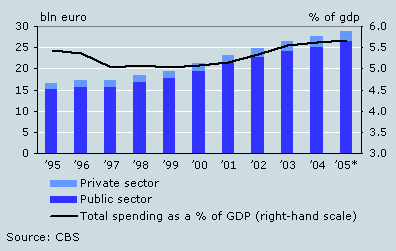Less spent per student in higher education

Together, the public and private sectors in the Netherlands spent a total 28.7 billion euro on education in 2005. This is 4 percent more than in 2004. Spending on primary and secondary education has risen sharply in the last ten years, unlike spending on higher education.
Education accounts for 5.7 percent of GDP
Central government, municipalities and provinces spent 23.6 billion euro on education institutions and 3.1 billion euro on student grants in 2005. In 2004 this expenditure amounted to 25.4 billion euro. Spending by households and private companies on education institutions amounted to 2.3 billion euro. This is 0.2 billion less than in 2004, mainly as a result of the abolition of tuition fees for a number of pupil categories on 1 August 2005. The share of education spending in the gross domestic product rose from 5.6 percent in 2004 to 5.7 percent in 2005.
Total spending on education

More spent on secondary education
This increase in public spending on education in 2005 is the result of among other things the fulfilment of obligations under the former care system to an amount of 0.4 billion euro. In addition, the number of students in secondary education and senior vocational education (mbo) increased. Furthermore extra funding was reserved for practical training rooms, a smoother transition from vocational training to the labour market, and more money was spent on combating and preventing truancy and drop-out.
The share of primary education in total public spending on education institutions rose substantially between 1995 and 2000, mainly at the expense of the share spent on university education.
Public spending on education institutions by type of education, 1995 and 2005

Strong rise in real education expenditure
After correction for inflation, spending on primary and secondary education in the period 1995–2005 rose by 54 and 38 percent respectively. In higher education, real spending rose by 18 percent. Real expenditure per pupil rose by 49 and 31 percent in primary and secondary education respectively. In higher education real expenditure per student rose slightly between 1995 and 2000, but fell by 4 percent between 2000 and 2005. This fall was caused by the increase in the number of students on the one hand, and the only slight growth of government funding on the other.
Netherlands average in an international perspective
In other countries, too, spending per pupil rose by more in primary and secondary education than in higher education. The Netherlands scores around average on an international scale with respect to spending per pupil/student in all categories of education.
International spending on education institutions per pupil/student, 2003

Broos Brouwers